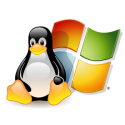
Chapter 1. When I recently started thinking about buying a new computer, I wanted to realize something I had been thinking about for a long time: switching to Linux as my primary operating system.
This article is the first one in a series that describes how I replaced Windows as the primary operating system on my workstation with Linux. This series is not meant as a “look how great Linux is” vs “Windows is the root of all evil“, quite the opposite in fact. The articles are meant as a continuing story of my adventures with the Linux operating system and to document how I did things.
I will detail my reasons in a future post, but let me make one thing clear: I have nothing against Windows or Microsoft. In fact I make my living installing and maintaining mainly Windows systems. I just want to try something different and new.
Research and lists
 I started out by doing a lot of research. The first task was to make a list of all things I use my computer (and Windows) for. This might seem very simple, but there are a number of tasks one does not perform very often. On the other side there are habits that we have and don’t even think about.
I started out by doing a lot of research. The first task was to make a list of all things I use my computer (and Windows) for. This might seem very simple, but there are a number of tasks one does not perform very often. On the other side there are habits that we have and don’t even think about.
This list includes things from filling out your taxes (once a year) to the way you save and browse for files on your computer. Switching to a completely different operating systems can (and probably will) change these things. Chances are you will have to find another way of doing them. In worst case you simply won’t be able to do them at all.
The next step is to make a list of applications you use for those tasks. Again this ranges from applications used on a daily basis (Internet, mail) to programs you might not even remember you had until you need them. Once you have this list of programs “in use” make sure to check it against the full list of programs that are installed on the computer.
Your next task is deciding what to switch to. What distribution do you want, what window manager? In other words: what flavour of Linux will you use and how does it have to look and act. Again, make a list of your expectations and compare them against the different distributions of Linux. Most distributions come with a built in (default) window manager, so that is a choice you can make later or don’t even have to make.
Distributions and looks
 For people that have been using Windows for years and never looked at Linux, this choice may be overwhelming. A good place to start is distrowatch, this site contains information about most (if not all) Linux distributions. They also have a list of the most popular Linux flavours. If you are just starting out, It might not be a bad idea to pick a popular distribution.
For people that have been using Windows for years and never looked at Linux, this choice may be overwhelming. A good place to start is distrowatch, this site contains information about most (if not all) Linux distributions. They also have a list of the most popular Linux flavours. If you are just starting out, It might not be a bad idea to pick a popular distribution.
I wrote an article detailing distributions in detail, so I won’t go into specifics here. The choice ranges from simple (Ubuntu, Fedora) to “Do It Yourself” (Arch, Gentoo). Just to be clear: the latter category of distro is not meant for beginners (unless you like frustration and insomnia of course).
Like all things in life: chose something you like, not something that other people want you to like. Also don’t worry too much about the window manager part (Gnome, KDE, Unity, Xfce,…), most distributions will let you change that afterwards. As for now don’t make a choice yet.
Will it run my programs?
 This is most likely one of the more difficult tasks in the switching process: trying to find out if a specific program exists for Linux. If it does not, we’ll have to search for an alternative.
This is most likely one of the more difficult tasks in the switching process: trying to find out if a specific program exists for Linux. If it does not, we’ll have to search for an alternative.
Let’s return to the list of programs that are in use on your computer. Locate and visit the site of the company that produced the software and check if they have a Linux version. If they have, check what distributions they support. This will help in the choice of your distro. If they don’t then we’ll have to look for an alternative, a piece of software that matches our needs completely or as close a possible.
This is not an easy process, often there are several choices. Picking the one you like best is mostly a case of trial and error. There are a couple of sites that try and compare Linux software with Windows software, but in most cases Google (or another search engine) is your friend. Searching for “Name of the software” linux alternative will do the job in most cases.
If absolutely no software exists, there is also Wine (not the beverage). This software allows Windows programs to run in Linux, but it has drawbacks. More about Wine in a later article, for now we’ll try and find some native Linux programs.
A small word of warning: it is not because Linux is open source and free, that all software running on Linux is free. Also there are a lot of sites that advertise free software, but don’t actually have anything for free (this is the same for Windows software). Like always: use your common sense. If a site has to tell visitors 3+ times they are offering something for free then it probably isn’t.
Let’s get testing
 Now that we have a list of things we do with our computer, the programs we want to do them with and the distribution(s) we want to try out, we have to determine how to test all this. Of course we want to make sure we don’t lose important data in the process. Neither do we want to end up with an unworkable system with no internet access and no way to solve problems.
Now that we have a list of things we do with our computer, the programs we want to do them with and the distribution(s) we want to try out, we have to determine how to test all this. Of course we want to make sure we don’t lose important data in the process. Neither do we want to end up with an unworkable system with no internet access and no way to solve problems.
In this case there are 2 “best ways” to do this: if you have a spare computer that is not too different from your current one, you could use that machine. The other possibility is even simpler and does not require extra hardware: test your distribution in a virtual machine.
Both methods have their advantages and drawbacks. I went for the Virtual machine route and chose Oracle Virtualbox. I wrote an article (Switching to Linux: The VirtualBox Test Setup) that describes how I setup my test environment in detail.
In any case: take your time and focus. Installing an operating system, configuring it, adding software and testing it takes time, lots of it. Also it is very easy to get distracted. Go in, keep your list of goals close and test. If you run into problems, don’t give up immediately but try to solve issues. However if something breaks really bad or you are not comfortable with the solution, make sure to stop the test before it becomes an endless time sink.
Switching to Linux series:
- Chapter 1 >> This Article
- Chapter 2 >> Switching To Linux: My Reasons
- Chapter 3 >> Switching To Linux: The Software List
- Chapter 4 >> Switching To Linux: The Distributions
- Chapter 5 >> Switching To Linux: The VirtualBox Setup
- Chapter 6 >> Switching To Linux: Expectations and Criteria
- Chapter 7 >> Switching To Linux: Distribution Testing
- Chapter 8 >> Switching To Linux: Testing Distributions On Real Hardware
- Chapter 9 >> Switching To Linux: Ubuntu, The Surprising Winner
Related posts:
- Switching To Linux: The Software List Chapter 3. As discussed in the first article in this...
- Switching To Linux: My Reasons Chapter 2. Before starting this series or even before starting...
- Switching To Linux: Expectations and Criteria Chapter 6.Now that we have established how we are going...
- Switching To Linux: The Distributions Chapter 4.Over the years I have tested and used a...
- Switching To Linux: The VirtualBox Setup Chapter 5.For this chapter of the series we’ll take a...


Sorry, the comment form is closed at this time.